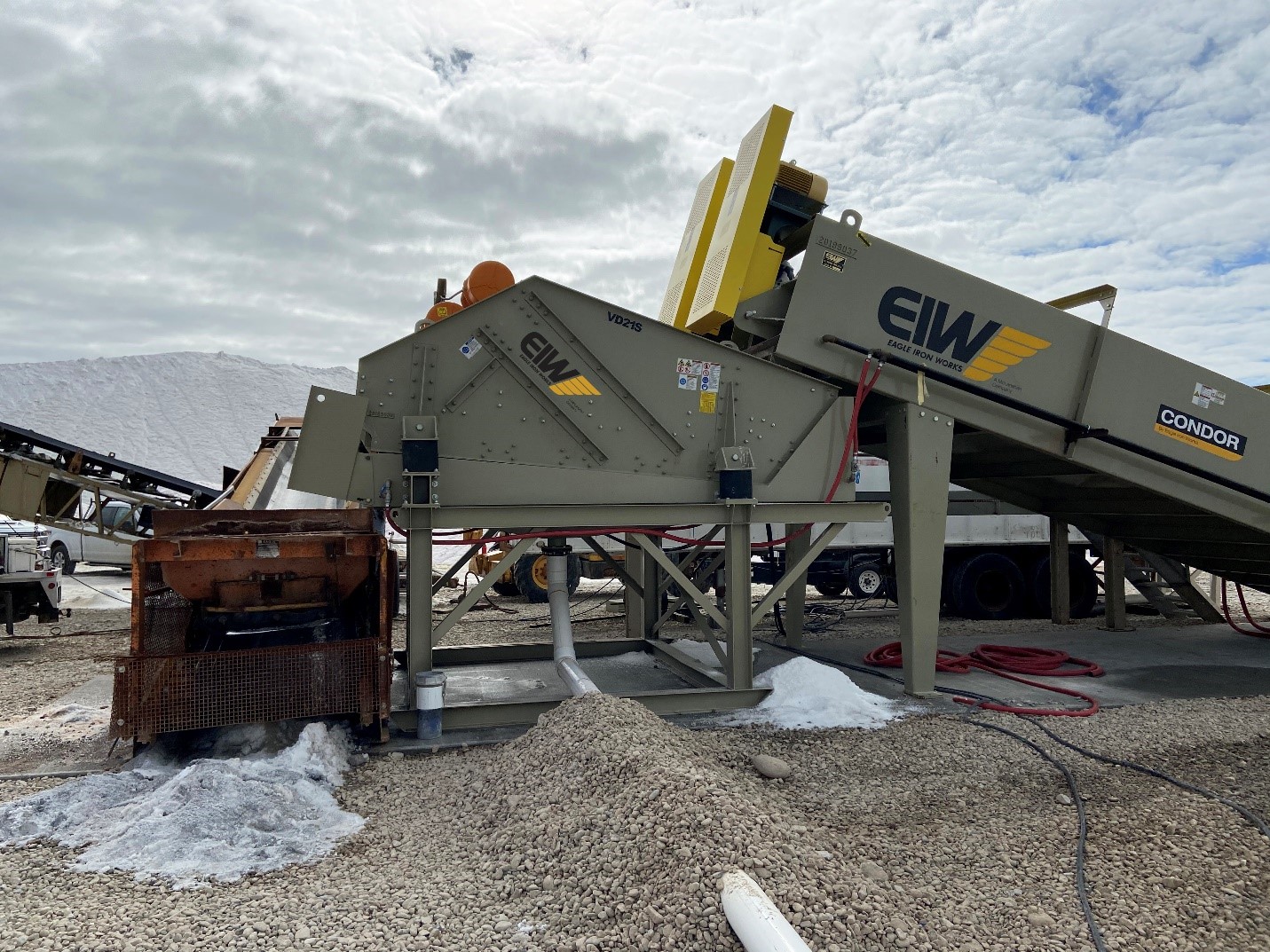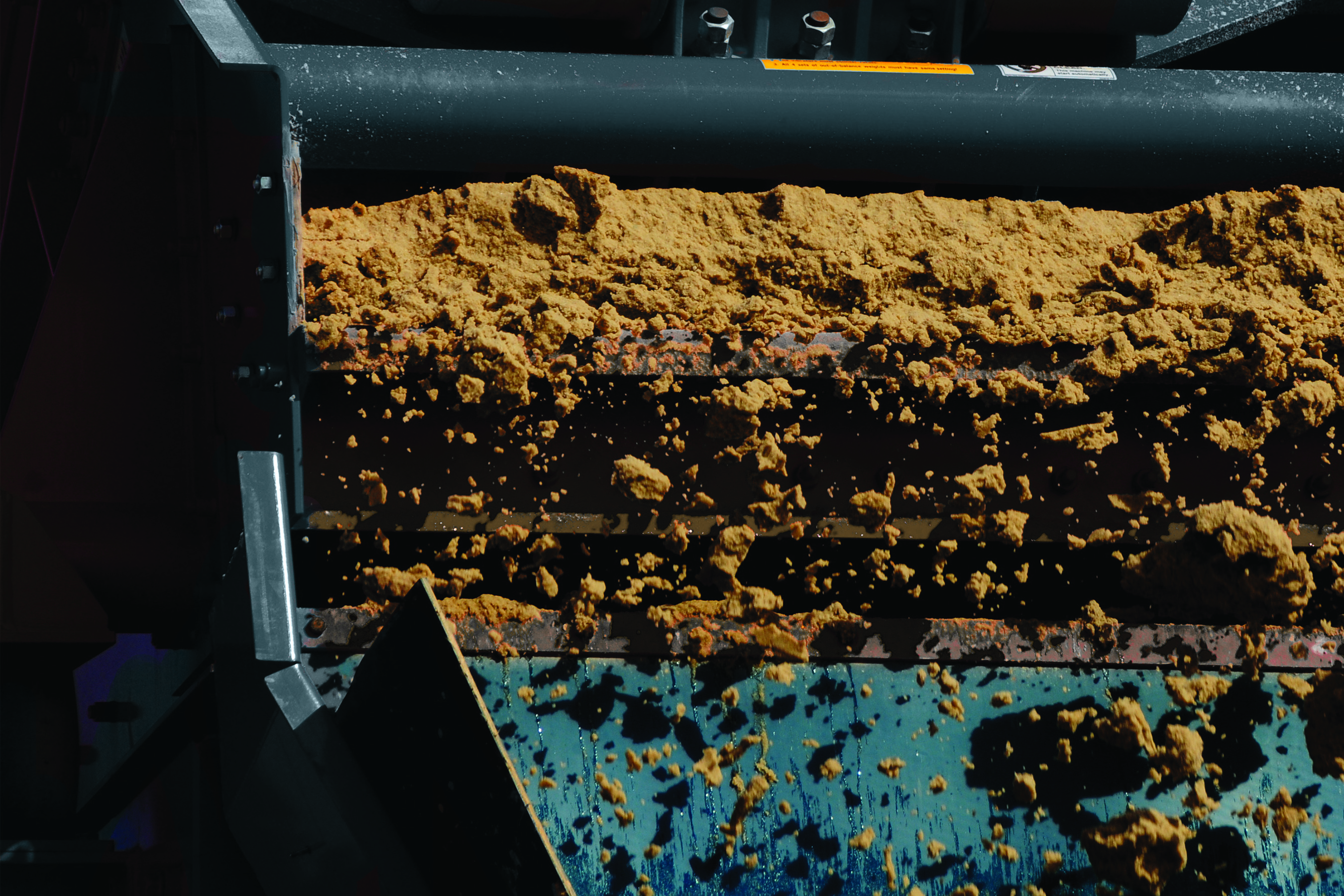
Improving Product Dryness with a Dewatering Screen
Washing is often required to get aggregate material to meet product specifications for use in various construction and infrastructure projects. It removes clay, silt, crusher dust, fines and other deleterious materials from the final product.
In all washing operations, water is a necessary part of the process but not desired in the final product. Equipment such as Fine Material Screws can remove a majority of the water used in the washing process, discharging a product that is around 20% moisture, but the sand will still need to sit in a stockpile for several days so the excess water can drain out.
With the addition of a Dewatering Screen after a screw washer, product moisture content can be reduced even further, allowing sand going onto a pile to be almost ready to load out.

An EIW Dewatering Screen placed after an EIW CONDOR Fine Material Washer to improve product dryness.
What is a Dewatering Screen?
Eagle Iron Works Dewatering Screens are designed to put the finishing touch on a partially dewatered material from a sand screw. They produce a drip-free product that has a moisture content of 7-15% depending on the material being dewatered. In all applications, the material that discharges from the Dewatering Screen is stackable and conveyable.
Although often considered new technology when compared to sand screws, Dewatering Screens have successfully been used to reduce moisture content in mined and washed materials since the 1970s.
These units can fit directly under any type of fine material screw to remove excess moisture before stockpiling. They are an asset to any washing application where a dewatered material is desired of the final product.
How Does A Dewatering Screen Work?
Dewatering Screens consist of a screen frame that supports urethane panels and two counter-rotating vibratory motors. Material is discharged from the sand screw directly onto the deck of the Dewatering Screen, where the vibrating motion of the motors in combination of high G-forces move the material toward the discharge chute.
As the material moves along forward on the screen deck, the water detaches from the sand particles and drains through the holes in the screen panels. This creates a deep bed of sand that retains particles much finer than the screen opening. The drip-free, dewatered sand can discharge directly onto a conveyor for stockpiling.
EIW’s Dewatering Screens are designed to be installed and operated in a horizontal orientation. This specification allows them to accept a partially dewatered product where a majority of the moisture has already been removed, such as that from a sand screw. This allows for a higher discharge point from the screen to accommodate stacking conveyors.

The EIW Dewatering Screen produces a drip-free product that is stackable and conveyable.
Additional Dewatering Screen Benefits
In addition to producing a drip-free product that is stackable and conveyable, Dewatering Screens provide the following benefits:
Improved Housekeeping
Dewatering Screens remove excess water from the final product. Less water in the product means less mess under the conveyors and less water that drains out around the stockpile for overall improved housekeeping.
Stockpile size can also be reduced with a Dewatering Screen. Less water in the product pile means the stockpile can be moved sooner, reducing the footprint of the stockpile.
Improved Sand Equivalency
As the excess water detaches from the sand particles and drains through the sand bed and screen media, it takes with it some fine particles that remain in the sand after washing. Optional spray bars can provide an additional rinse to wash out even more fine material to improve the bottom end of a gradation and Sand Equivalency.
Fines Recirculation
If the goal is to capture or retain as much of the fine material as possible, Dewatering Screens can be outfitted with a sump and pump to recirculate fines that naturally leave the product stream with the water back to the screw washer to re-enter the product stream.
Reduced Fresh Water Usage
By adding a pump to the sump of the Dewatering Screen, the water removed from the final product can be recirculated back to the Fine Material Washer to reduce freshwater requirements.
The water can be supplied back to the screw in two places: in the tub area to reduce the fresh water required for the washing process, and near the discharge end to wash out additional fines.
Dewatering Screens are a great addition to any application that requires a dewatered final product. They produce a drip-free material that is stackable and conveyable, and provide additional benefits of improved housekeeping and Sand Equivalency, reduced freshwater usage and the recirculation of fine material into the product stream.
